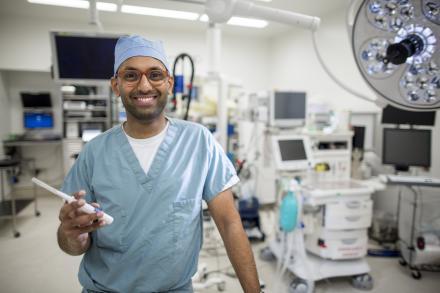Ann Arbor: In a first for glaucoma treatment, the University of Michigan Kellogg Eye Center has used a tiny tube, implanted in the eye, to preserve vision. The XEN® Gel Stent
creates an opening between the inside of the eye – called the anterior
chamber – and the eye’s outer layer to allow fluid to drain, potentially
decreasing pressure in the eye. This helps preserve vision by reducing
intraocular pressure to a normal level. It’s a new way to treat glaucoma performed this week by glaucoma specialist Manjool Shah, M.D., and part of the advent of minimally invasive glaucoma surgery (MIGS) devices to help adults with mild-to-moderate glaucoma.
Millions of Americans have glaucoma, a group of diseases that can
damage the optic nerve. Open-angle glaucoma is the most common form of
glaucoma.
When fluid builds up, the pressure inside the eye rises to a level
that may damage the optic nerve. If left untreated, glaucoma will cause
a slow but steady loss of vision.
The current management approach begins with medical therapy,
including eye drops, followed by laser trabeculoplasty and then either a
trabulectomy and a glaucoma drainage device.
Both are highly effective, yet invasive and complication-prone solutions.
“MIGS procedures are generally faster than trabulectomy and tube
shunt surgeries, and shortened surgical and recovery times can be very
important to patients,” says Shah, a clinical instructor in the
University of Michigan Department of Ophthalmology and Visual Sciences.
The XEN gel stent is made of a soft but permanent gelatin material.
It is 6 mm long and about the width of a human hair. Doctors inject the
stent through a small self-sealing corneal incision using a simple,
preloaded injector.
Kellogg is among the first eye centers in the country to offer the
treatment option after clinical trials showed it was safe for patients.
Late last year, the U.S. Food and Drug Administration approved it for use (link is external) in the United States.
It’s intended to reduce intraocular pressure in patients with primary
open angle glaucoma where previous medical treatments have failed, or
for the management of refractory glaucomas, where previous surgical
treatment has failed.
Through teamwork, compassionate care, innovation and integrity Kellogg is one of the most advanced eye centers in the world.
Kellogg turns scientific advancements into more effective treatments and cures for eye disease, for adults and children, from corneal crosslinking to exploring new options in retinal imaging.
